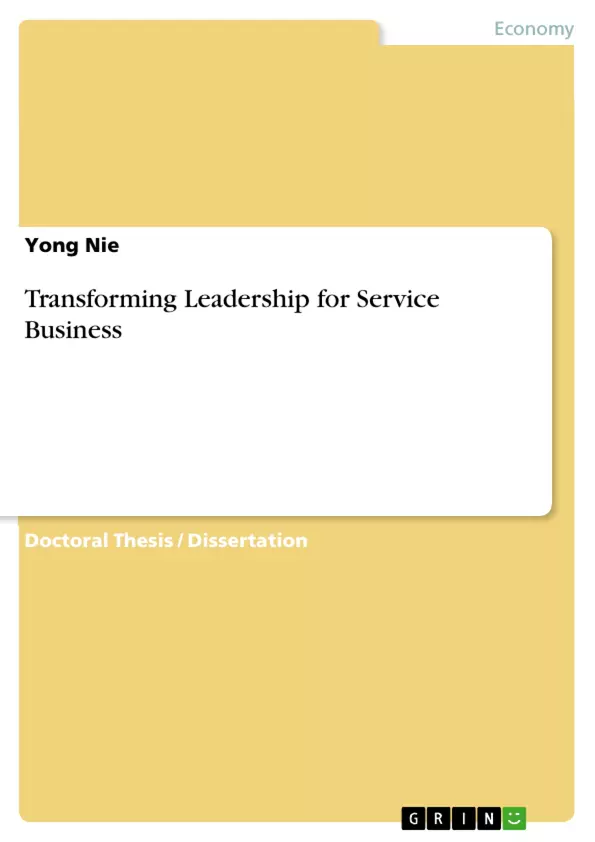Customers are increasingly becoming active participants and co-creators of value in the mobile Internet era. With this trend, employees are encouraged to engage in active dialogue with customers, effectively manage customer diversity and co-create personalized experiences. Such changes challenge the leadership. The relevant literature reveals that the significance to leadership of shared vision has attracted attention and become widely acceptable. However, there is a large gap in the literature regarding how to model the building of shared vision in service business.
Our study represents a first attempt to shed light on how vision co- creation between leaders and employees can affect the leadership in corporate transformation. Based on comparisons of the leadership literature regarding product-oriented and service-oriented companies, we hypothesised about vision co-creation with employees. Then, we conducted an in-depth case study in a leading software company in China and interviews in four multinational IT companies in Japan. This study suggests that vision co-creation with employees is imperative for leaders in today’s service-dominant business. In the co-creation process, six relevant working states of employees are defined: non-engagement, expectation, satisfaction, engagement, loyalty and creativity. As a firm creates a new vision, or makes the existing corporate vision into a shared vision, it goes through these phases. We propose specific implications of the issues and focus on each phase to address the concerns.
This research makes a contribution by addressing concerns that many companies are over-managed and under-led. Traditional management systems, such as management rules, PDCA, performance appraisals and incentive systems, are still indispensable but are not enough to lead employees to work in the high-tier state. The co-creation process makes the new vision come alive so that it can be imagined, experienced, pursued and worked hard for.
In the final chapter, we provide suggestions for future research. The position-centred, one-person leadership described in the previous literature leaves the substantial talents of employees largely untapped.
Inhaltsverzeichnis (Table of Contents)
- Chapter 1: Introduction
- 1.1 Background
- 1.1.1 The increasing IT service market in the global economy
- 1.1.2 Service-oriented corporate transformation as a competitive strategy
- 1.1.3 Challenges for leaders in corporate transformation
- 1.2 Research objectives
- 1.3 Research questions
- 1.4 Research Methodology
- 1.5 Originality and significance of the research
- 1.6 Structure of the chapters
- Chapter 2: Theoretical Review of Service Science and Leadership
- 2.1 Introduction
- 2.2 Emerging theories in service science
- 2.2.1 Service-dominant logic
- 2.2.2 Service field
- 2.2.3 Value co-creation with customers
- 2.3 General leadership theories
- 2.3.1 Definitions of leadership
- 2.3.2 Traditional leadership theories
- 2.3.3 Transactional and transformational leadership
- 2.3.5 The role of shared vision in leadership building
- 2.4 The contrast of leadership in goods- and service-dominant Logic
- 2.5 Summary and proposition: vision co-creation leadership for value co-creation business
- Chapter 3: Case Study Design
- 3.1 Introduction
- 3.2 Two groups of companies for case studies
- 3.2.1 Chinese companies as fast-developing cases
- 3.2.2 Japanese multinational companies as well-developed cases
- 3.3 Attributes of the companies
- 3.4 Interview methods
- 3.5 Data collection and Analytic strategy
- Chapter 4: Case Analysis and Discussion
- 4.1 Introduction
- 4.2 Chinese cases from Kingdee
- 4.2.1 Company A
- 4.2.2 Company B
- 4.3 Japanese Case Company – Company J
- 4.3.1 Profile of the company
- 4.3.2 The problems of building the shared vision
- 4.3.3 The actions taken to resolve these problems
- 4.3.4 The results
- 4.3.5 The process of building shared vision at a large department level
- 4.4 Summary
Zielsetzung und Themenschwerpunkte (Objectives and Key Themes)
This research examines the impact of value co-creation with customers on leadership and identifies fundamental changes in leadership during service-oriented corporate transformation. It aims to build a vision co-creation model to assist leaders in rethinking their behaviors, focus, and impact for effective leadership in service-oriented businesses.
- The significance of shared vision in service-oriented business.
- Vision co-creation as a means to align individual and corporate visions.
- The importance of open communication and employee involvement in vision building.
- The impact of a shared vision on organizational culture and employee engagement.
- The role of leadership in facilitating a climate of empathy and collaboration.
Zusammenfassung der Kapitel (Chapter Summaries)
Chapter 1 provides an introduction to the research, outlining its background, objectives, research questions, methodology, originality, and significance. It also introduces the structure of the thesis.
Chapter 2 reviews the literature on service science and leadership, exploring emerging theories in service science, general leadership theories, and contrasting leadership in product-oriented and service-oriented businesses. It concludes by proposing the concept of vision co-creation with employees.
Chapter 3 describes the case study design, outlining the selection of two groups of companies for case studies: Chinese companies as fast-developing cases and Japanese multinational companies as well-developed cases. It also introduces the attributes of these companies, the interview methods employed, and the data collection and analytic strategy used.
Chapter 4 presents the case analysis and discussion, focusing on two subsidiary companies of Kingdee International Software Group Company Limited (Kingdee) in China and one Japanese multinational company (Company J). The analysis explores the vision co-creation process in each company, identifying the problems encountered, actions taken to address them, and the resulting outcomes. It concludes with a summary of the findings.
Schlüsselwörter (Keywords)
The primary keywords and focus topics of this text are service-dominant logic, value co-creation, shared vision, vision co-creation, leadership, corporate transformation, employee engagement, organizational culture, and case studies.
- Quote paper
- Yong Nie (Author), 2014, Transforming Leadership for Service Business, Munich, GRIN Verlag, https://www.grin.com/document/369698



